In the evolving landscape of customer service, AI and automation are increasingly pivotal, promising enhanced efficiency and customer satisfaction. However, a significant hurdle remains: the effective interpretation and utilization of the vast data generated by these technologies. As businesses integrate AI solutions, they encounter challenges in setting clear metrics to assess their impact and justify further investments. This article explores these challenges, drawing insights from key industry reports and examples to outline practical approaches for harnessing AI-generated data to improve customer operations.
The Gap in AI Readiness and Impact Measurement
In the realm of customer service, the adoption of AI and automation technologies is accelerating, yet there remains a notable “AI readiness gap” between leadership enthusiasm and the realities on the ground. According to the Intercom report, while a majority of customer service leaders are eager to harness AI’s potential, frontline practitioners are less convinced about AI’s readiness and their ability to effectively integrate it into their daily tasks.
This gap impacts how AI initiatives are communicated and implemented across organizations. The report reveals that over two-thirds of support leaders are confident in AI’s capabilities and believe that customers are ready to interact with AI-driven systems like chatbots. However, less than half of the support practitioners share this confidence, signaling a divide that could hinder the operational success of AI technologies in customer service environments.
To bridge this readiness gap, it is crucial for leaders to not only advocate for the benefits of AI but also to invest in training and support systems that help practitioners understand and leverage AI tools effectively. This includes establishing clear metrics for measuring the success of AI implementations—metrics that go beyond theoretical benefits and demonstrate tangible improvements in customer satisfaction and operational efficiency.
Understanding this gap and addressing it head-on is essential for organizations to not just implement AI technologies, but to optimize them to meet the evolving demands of customer service. By aligning the perspectives of leaders and practitioners, businesses can ensure that their investments in AI deliver real value, both to their teams and their customers.
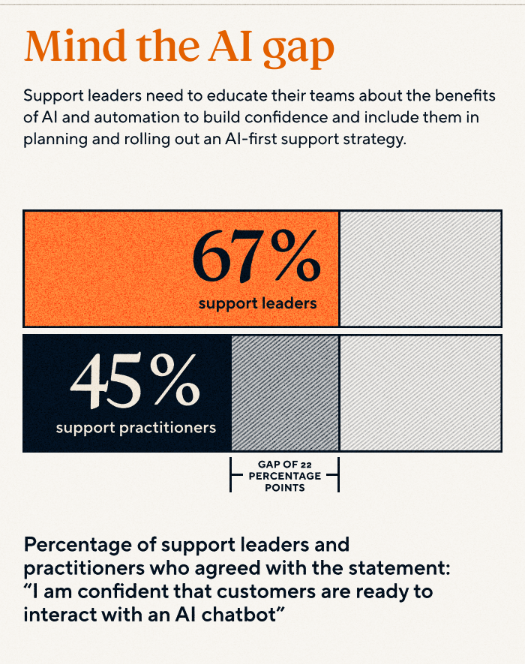
Understanding Data Observability in AI Systems
In the context of customer service, where AI systems generate a significant amount of data, understanding and managing this data becomes critical. Data observability offers a framework through which businesses can monitor and maintain the health of their data systems—an essential component given the complexity of data interactions within AI-driven operations.
- Fundamental Principles of Data Observability: Data observability encompasses several key principles that ensure data quality and system reliability. These include real-time continuous monitoring throughout, comprehensive logging, and automated anomaly detection. Each of these components helps organizations quickly identify and address issues that could affect data accuracy and application performance.
Impact on AI Data Interpretation: For AI systems in customer service, data observability is not just about monitoring; it’s about understanding how data flows through AI models and how these models affect customer interactions. By employing training data observability, businesses can trace errors back to their sources, understand the performance of AI models, and make informed decisions about adjustments or improvements needed.
- Business Case for Data Observability: Implementing data observability helps businesses preempt problems that could lead to poor customer experiences or faulty decision-making based on inaccurate data. This is particularly important in AI applications where the stakes are high—such as in predictive customer service tools, where failing to address issues promptly can lead to customer dissatisfaction and potential revenue loss.
- Applying Best Practices for Scalable Data Observability: As AI applications scale, the complexity of data also increases. Adopting best practices in data observability ensures that businesses can scale their AI operations without losing sight of data integrity. These practices include setting up robust data pipelines, employing advanced tools for data monitoring, and fostering a culture of data-centric decision-making among teams.
By thoroughly understanding data observability and integrating its principles into AI operations, businesses can enhance the reliability of data privacy in their AI systems and, ultimately, improve the overall quality of customer service. This strategic approach not only addresses the immediate challenges of data management but also sets the foundation for sustained innovation and competitive advantage in the rapidly evolving AI landscape.
Five Pillars of Data Observability
In the context of customer service, where AI systems generate a significant amount of data, understanding and managing this data becomes critical. Data observability offers a framework through which businesses can monitor and maintain the health of their data systems—an essential component given the complexity of data interactions within AI-driven operations.
- Fundamental Principles of Data Observability: Data observability encompasses several key principles that ensure data quality and system reliability. These include real-time monitoring, comprehensive logging, and automated anomaly detection. Each of these components helps organizations quickly identify and address issues that could affect data accuracy and application performance.
- The Five Pillars of Data Observability: The framework is built on ai model: five critical pillars:
- Freshness: Timely updating of data assets to ensure they are current and relevant.
- Distribution: Monitoring of data distribution to detect unexpected anomalies.
- Volume: Keeping track of data volume to identify significant deviations that could indicate problems.
- Schema: Observing changes in data organization or schema that might impact data integrity.
- Lineage: Understanding the data lineage to trace errors back to their sources and understand data dependencies.

- Impact on AI Data Interpretation: For AI systems in customer service, data observability is not just about monitoring; it’s about understanding how data flows through AI models and how these models affect customer interactions. By employing observability, businesses can trace errors back to their sources, understand the performance of AI models, and make informed decisions about adjustments or improvements needed.
- Business Case for Data Observability: Implementing data observability helps businesses preempt problems that could lead to poor customer experiences or faulty decision-making based on inaccurate data. This is particularly important in AI applications where the stakes are high—such as in predictive customer service tools, where failing to address issues promptly can lead to customer dissatisfaction and potential revenue loss.
- Applying Best Practices for Scalable Data Observability: As AI applications scale, the complexity of data also increases. Adopting best practices in data observability ensures that businesses can scale their AI operations without losing sight of data integrity. These practices include setting up robust data pipelines, employing advanced tools for data monitoring, and fostering a culture of data-centric decision-making among teams.
Evaluating AI’s role in Customer Interactions
As artificial intelligence continues to evolve, its integration into customer service operations offers unprecedented opportunities to enhance interaction quality and efficiency. AI’s capabilities now extend beyond routine query resolution to facilitating complex and contextually rich conversations between customers and machines.
Capabilities of AI in Customer Service: AI technologies, especially advanced chatbots and generative AI, are transforming how customer inquiries are managed. Initially designed to handle basic information requests or frequently asked questions, AI systems have now progressed to managing more complex inquiries. This shift is largely due to improvements in natural language processing (NLP) and machine learning models, which allow for a more nuanced understanding of customer needs and the ability to deliver more personalized responses.
Real Conversations with AI: The eBook “The Future of Support Conversations” highlights that modern AI systems are capable of simulating real conversations. This includes generating responses that are not only relevant but also context-aware, providing a conversational experience that can adapt to the tone and flow of human interactions. This capability is critical in ensuring that AI can handle a broader range of customer service scenarios without human intervention.
Generative AI and Customer Service: The role of generative AI in customer service is particularly notable. Systems like ChatGPT have revolutionized the potential of AI to generate dynamic content responses that are tailored to individual user interactions. This capability allows customer service departments to scale their operations effectively, handling more customer interactions with less human oversight.
Challenges in AI Interactions: Despite these advancements, there remain significant challenges in ensuring AI interactions meet customer expectations. The eBook discusses issues such as the limitations of AI in understanding complex human emotions and subtleties. Furthermore, AI systems can sometimes generate inaccurate or misleading information, a phenomenon known as “hallucination” in AI parlance, which can lead to customer dissatisfaction.
Human-AI Collaboration: To mitigate these challenges, the eBook suggests a collaborative approach where AI systems are used in conjunction with human customer service agents. AI can handle initial customer interactions and escalate more complex issues to human agents. This not only ensures efficiency but also maintains a high quality of service where human empathy and understanding are crucial.
By evaluating the role of AI in customer interactions through ai adoption these lenses, businesses can better integrate these technologies to enhance their customer service operations while also preparing for the challenges that come with AI implementation. This strategic approach allows for the optimization of resources and improves the overall customer experience.
The Conversational Support Funnel: Optimizing Customer Interactions
The Conversational Support Funnel is a strategic framework developed by Intercom to optimize customer interactions by categorizing them into distinct stages—Proactive, Self-Serve, and Human Support. This funnel is designed to enhance the efficiency of customer service operations while maintaining high satisfaction levels. At the Proactive stage, businesses anticipate and address customer needs before they arise, using targeted messaging and notifications. This reduces the volume of incoming queries by resolving issues before they escalate. The Self-Serve stage empowers customers to find answers independently through comprehensive FAQs, knowledge bases, and automated chatbots, which are pivotal in offloading routine inquiries from human agents. Lastly, the Human Support stage is reserved for more complex issues that require empathy, nuanced understanding, or detailed technical knowledge, ensuring that customer service agents focus on interactions where human touch adds the greatest value. This funnel not only streamlines service operations but also aligns them more closely with customer expectations, creating a smoother, more responsive experience. By implementing the Conversational Support Funnel, companies can strategically deploy their resources, leveraging AI and automation to handle routine interactions while preserving human expertise for where it’s most impactful.
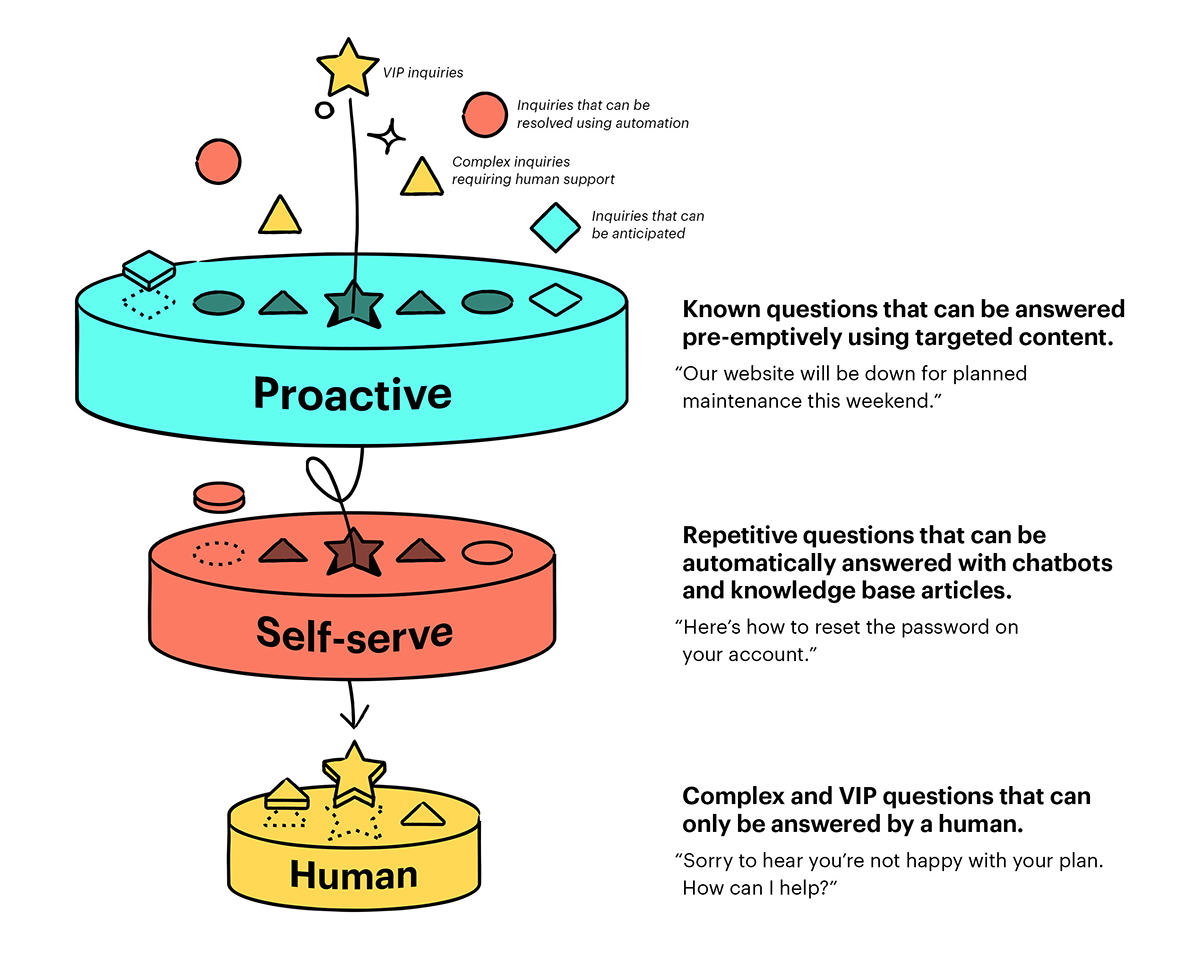
Choose a Support Method
Human support, self-serve options, and proactive measures each play unique roles in customer service, specializing in various tasks to achieve distinct objectives within a service team:
- Proactive Support: This initial stage of the funnel involves anticipating customer issues before they arise. By employing proactive notifications and targeted communications, businesses can address potential problems early, reducing the need for direct customer inquiries and enhancing overall satisfaction.
- Self-Serve Support: At this stage, customers are empowered to find solutions on their own through easily accessible resources like FAQs, knowledge bases, and automated tools such as chatbots. Self-serve support is crucial for efficiently managing high volumes of common queries, allowing customers to resolve issues quickly without the need for direct interaction with service personnel.
- Human Support: Reserved for more complex and sensitive issues, human support provides the necessary empathy and expert problem-solving that automated systems cannot offer. This level of support is essential for handling intricate customer needs that require a personalized touch or detailed technical assistance, ensuring that customer concerns are met with understanding and expertis
Each segment of the funnel is designed to optimize the allocation of resources, ensuring that every type of inquiry is handled in the most efficient and effective manner possible, thereby enhancing the overall customer experience and operational efficiency.

Strategic Integration of AI with Human Support
The effective integration of AI tools and human customer service agents forms a cornerstone of modern customer service strategies, optimizing outcomes and enhancing customer satisfaction. This strategic integration leverages the strengths of both AI technologies and human empathy to provide a comprehensive service experience.
AI Augmentation in Customer Interactions: AI tools excel in handling routine queries and providing instant responses, which significantly reduces wait times and increases efficiency. However, AI also plays a crucial role in augmenting human capabilities by providing agents with real-time data, suggested responses, and customer interaction histories. This information helps agents make informed decisions and personalize their interactions, thereby enhancing the quality of service.
Human Oversight and Emotional Intelligence: While AI can manage a vast amount of customer data, and handle initial inquiries, human agents are irreplaceable when it comes to their emotional intelligence and ability to manage complex customer emotions. Human agents can perceive subtleties in tone and context that AI may overlook, allowing them to effectively handle sensitive or complicated issues. This human touch is essential for maintaining trust and satisfaction among customers, particularly in escalated or nuanced scenarios.
Seamless Handoffs Between AI and Humans: A key aspect of integrating AI with human support is the seamless handoff process. AI systems are designed to recognize their limitations and transfer the interaction to human agents when a query surpasses certain complexity thresholds or when the customer expresses dissatisfaction with automated responses. This ensures that customers feel continuously supported and valued using ai only, even when their needs transcend the capabilities of AI.
Training and Continuous Learning: To maximize the synergy between AI and human agents, ongoing training is crucial. Agents must be trained not only in customer service skills but also in how to effectively utilize AI tools. Likewise, AI systems must be continuously updated and trained on new data to improve their accuracy and relevance. This mutual growth fosters an adaptable and responsive customer service environment where both AI and human agents evolve in response to changing customer needs.
By strategically integrating AI with human support, businesses can create a dynamic and responsive customer service system that leverages the best of both worlds. This synergy not only improves efficiency and customer satisfaction but also ensures that the human aspect of customer service remains strong in an increasingly digital world.
Harnessing AI for Enchanced Support Capabilities
A compelling illustration of AI’s transformative impact on customer service is encapsulated in the “The Power of Automation” graphic, which surveys the perceived benefits among support leaders. It shows that a significant 44% of leaders recognize that AI facilitates continuous, round-the-clock support, a capability pivotal in today’s global, always-on economy. Additionally, 37% of leaders acknowledge that AI contributes to faster support responses, effectively reducing wait times and improving customer satisfaction. A better overall customer experience is noted by 29%, illustrating AI’s role in creating more engaging and personalized interactions. Furthermore, 28% of leaders appreciate how AI and automation streamline workflow by taking over manual tasks such as summarizing conversations, freeing agents to tackle more complex and rewarding work. This graphic conveys a clear message: the strategic implementation of AI in customer support is not only enhancing operational efficiencies but also elevating the quality of service provided to customers.
Leverage AI alongside your existing tech stack
Cassey Bowden, Director of Sales at Promet Source, says: “it’s a great idea to consider using AI to improve marketing strategies. When effectively used with other equipment and skills of our respective team there are many possibilities. I’d encourage people to think AI can help with digital tools. Whoever gets to know the best results and gets most benefit from AI, in my view, are those that look at the technology from a Venn diagram perspective. When this overlaps, we can use the technology to leverage our existing technology stack in addition to our highly experienced workforce where this overlaps.”
AI Risk Mitigation Strategies
Quality control and reliability
AI-generated material can be highly inaccuracies that are particularly crucial for medical, legal, medical or other applications. For medical purposes AI algorithms are often used for the production and evaluation of radiographic data using medical image data. This software provides radiologists with an opportunity for rapid analysis. In contrast to reports produced by human radiologists the reports may occasionally be a source of error, misinterpreted and miss crucial detail. Mitigation methods for addressing AI challenges are essential for quality and reliability.
Step 1 – Enforce an AI Use Policy in Your Organization
In order to effectively manage AI risk enterprises must implement an AI-enabled policy which is fully understood and complies with. In a survey conducted by the Harvard Business School, a company spoke about AI in a recent interview and questioned 65% if it had been implemented. Hence, it is important to ensure comprehensive training in addition to policies. Training should follow a standard AI policy tailored to a particular role or situation to ensure a safe and effective environment.
Step 2 – Responsibly Using First-Party Data and Sourcing Third-Party Data for Ethical AI Use
A successful generative machine learning system is dependent on responsible and reliable usage of data. Owner data provides control and legality, and source data requires a trustworthy source with adequate permission. This approach ensures training of the generative AI models using low quality training data and does not violate copyright. Enterprises also need to check the data-sourcing strategies used to identify faulty data sources.
Step 3 – Invest in Cybersecurity Tools That Address AI Security Risks
Almost half (78%) of all cyber attack cases have been caused by misuse of AI. This situation shows that security measures are urgently needed. The generative artificial intelligence model lacks the native security infrastructure enabling it to be vulnerable. Enterprises should view the model as part of their network attack surface.

Future Directions: Automation, AI, and Countinuous Improvement
In the future landscape of customer service, automation and AI are not just tools; they are transformative forces reshaping the very fabric of customer interactions and support. The State of AI in Customer Service 2023 Report by Intercom reveals that a staggering 69% of support leaders are gearing up to invest more in AI technologies. These investments are driven by the recognition of AI’s ability to enhance efficiency and improve customer satisfaction—critical goals in today’s competitive environment.
The report outlines several anticipated benefits that forecast a promising future for AI in customer service:
- Increasing Efficiency: 66% of support leaders look forward to leveraging AI for efficiency gains, anticipating that this technology will reduce support costs over the next five years.
- Enhancing Customer Service Metrics: Leaders expect AI to positively influence core metrics like time to resolution, support organization costs, customer effort score, and customer satisfaction (CSAT).
- Shaping Customer Expectations: A considerable majority, 73%, believe customers will expect AI-assisted service within five years, underlining the urgency of adoption to stay competitive.
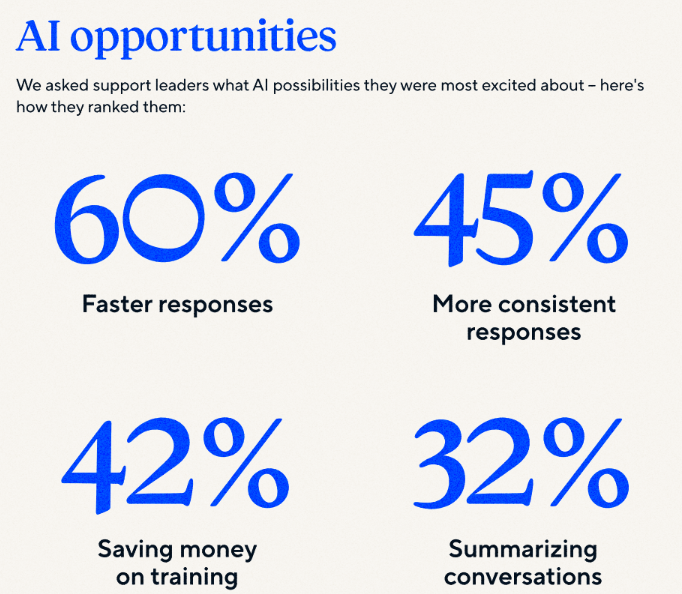
The Future of Support Conversations: Automation, AI, and AutoQA eBook further underlines AI’s role in quality assurance and the growing need for customer service to adapt to AI-assisted interactions. As AI becomes more prevalent, customers will begin to anticipate such levels of service as the standard.
However, integrating AI into customer service is more than just a technological upgrade—it’s about rethinking roles and workflows. Over three-quarters of support leaders anticipate that AI will create new opportunities, transforming careers and introducing roles like chatbot developers, conversation designers, and AI chatbot strategists. As AI and automation continue to evolve, customer service teams will increasingly rely on these technologies to meet and exceed customer expectations. The commitment to continuous improvement in AI applications will be essential for businesses to maintain a competitive edge, provide exceptional customer service, and foster career growth within their teams.
How AI improves the Customer Effort Score (CES)
Customer Effort Score (CES) is a crucial metric for measuring customer satisfaction. Rather than focusing solely on flashy features, companies can win customer loyalty by efficiently solving their problems. AI plays a pivotal role in enhancing CES scores:
- Automated Responses: Chatbots and virtual assistants provide quick and consistent answers, reducing customer effort.
- Learning from Interactions: Machine learning analyzes customer feedback to identify common issues and patterns.
- Streamlining Processes: AI suggests improvements to minimize repeated contact, information repetition, and channel switching.
By leveraging AI, businesses can enhance customer experiences and drive loyalty. Remember, it’s not about bells and whistles; it’s about solving problems effectively.
Optimizing Performance with AI: A Closer Look at Evolving Metrics
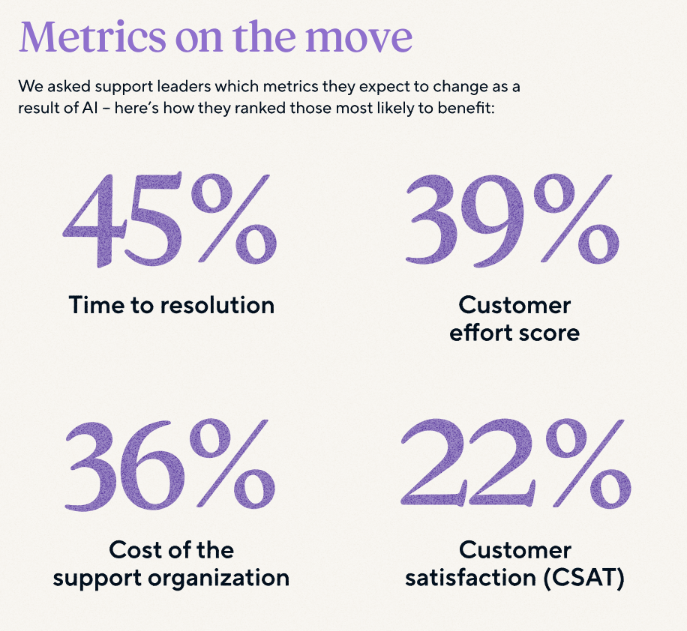
As customer service departments embrace AI, they anticipate a significant shift in performance metrics, predicting that AI will streamline operations and enhance customer interactions. According to the “Metrics on the Move” graphic, the most considerable expected improvement is in the “Time to Resolution,” with 45% of support leaders foreseeing AI to reduce the time it takes to resolve customer issues. Close behind, 39% of leaders believe that the “Customer Effort Score” will benefit, indicating that AI will make it easier for customers to get the help they need. In terms of cost efficiency, 36% predict that AI will reduce the overall “Cost of the Support Organization,” highlighting the potential for AI to contribute to financial savings. Lastly, the “Customer Satisfaction (CSAT)” score is also on the radar, with 22% of leaders expecting AI to boost customer happiness directly. This graphic demonstrates the multifaceted benefits AI is projected to bring to customer service, painting an optimistic picture of future interactions where AI enhances every aspect of the customer journey.
Navigating the Future with AI and Machine Learning in Customer Service
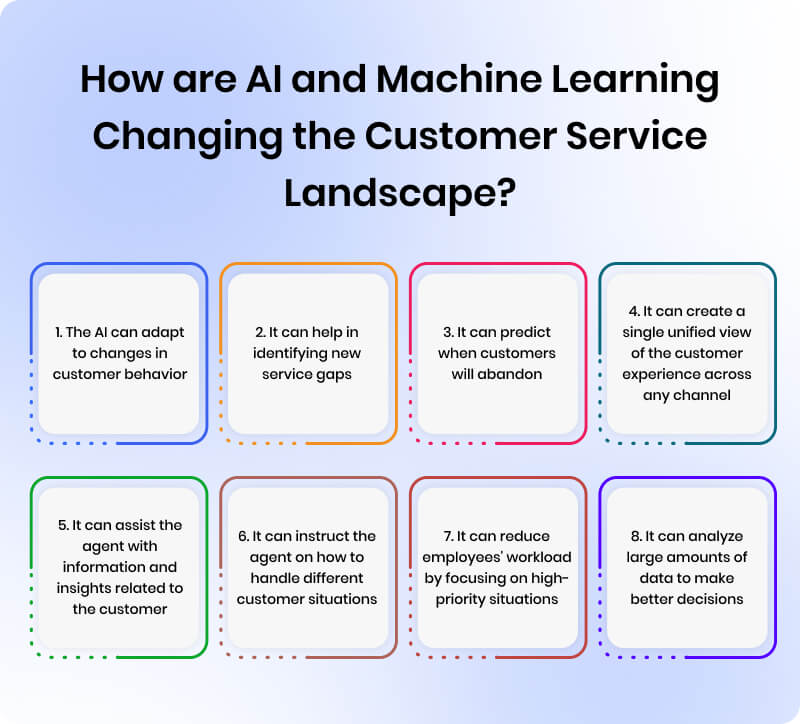
The transformative impact of AI and machine learning on the customer service landscape is profound and multifaceted. The insightful diagram illustrates the various ways in which these technologies are revolutionizing service delivery:
- Adaptability to Customer Behavior: AI’s ability to adapt to changes in customer behavior allows services to be dynamically tailored to meet evolving needs.
- Identification of Service Gaps: Machine learning algorithms excel in identifying new service gaps, enabling businesses to proactively enhance their offerings.
- Prediction of Customer Actions: Predictive analytics powered by AI can forecast customer actions, such as predicting when they might abandon a service or product, allowing for timely interventions.
- Unified Customer Experience: AI systems are capable of creating a single, unified view of the customer experience across various channels, ensuring consistency and personalization.
- Agent Assistance: AI provides agents with valuable information and insights related to the customer, enriching interactions with data-driven context.
- Guidance on Customer Situations: Beyond data provision, AI can guide agents on handling various customer situations, offering suggestions and support in real-time.
- Workload Reduction for Employees: By focusing on high-priority situations, AI can significantly reduce employees’ workloads, enabling them to concentrate on tasks that require a human touch.
- Data-Driven Decision Making: The ability of AI to analyze large volumes of data not only informs better decision-making but also uncovers insights that can drive strategic business improvements.
AI and machine learning are not just reshaping customer service; they are setting a new standard of excellence. As businesses look ahead, the integration of these technologies promises a customer service paradigm that is more responsive, intelligent, and efficient, marking the dawn of an era where customer satisfaction and operational excellence go hand in hand.
Concluding Thoughts
As we look to the horizon of customer service, it’s clear that the winds of change are driven by the sails of AI and automation. The insights gleaned from industry leaders through reports and practical case studies illustrate a future where AI empowers support teams, augments human interactions, and redefines the metrics of success. The anticipated advancements in AI capabilities promise not only improved efficiency and cost-effectiveness but also a deeper, more personalized approach to customer satisfaction.
Concluding our journey through the evolving landscape of customer operations, we find that the strategic integration of AI is not a distant future—it’s an unfolding present. Support leaders are not only forecasting but actively planning for an ecosystem where AI tools and human insight converge to create unparalleled service experiences. This synergy aims to deliver customer support that is accessible around the clock, intuitively understands and addresses customer needs, and continually evolves through learning and adaptation.
In embracing this technological transformation, businesses must navigate the dual challenges of technological implementation and ai challenges of human adaptation. By investing in AI and its integration with skilled human support, companies can unlock new potentials in service delivery, ensuring they not only meet but exceed the expectations of an increasingly sophisticated customer base. The future of customer service, as portrayed through the data, is one where every interaction is an opportunity to demonstrate efficiency, empathy, and excellence—a trifecta that will define the leaders in the space.
Sources:
https://appinventiv.com/blog/ai-risks/
https://www.revechat.com/blog/ai-in-customer-service/
https://coda.io/@intercom/the-conversational-support-funnel-toolkit/optimize-your-funnel-2
https://www.intercom.com/blog/conversational-support-funnel-starter-kit/
https://www.montecarlodata.com/blog-what-is-data-observability/

